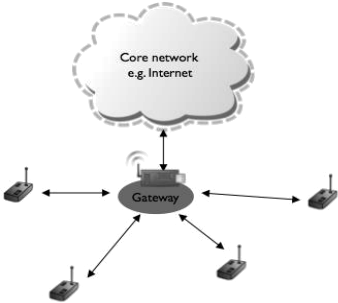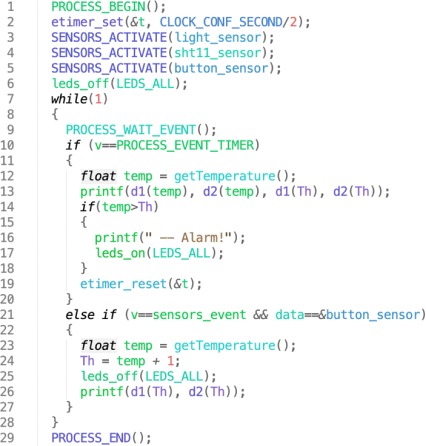EEEM048: Internet of Things Semester 1 2020/1
Hello, dear friend, you can consult us at any time if you have any questions, add WeChat: daixieit
Faculty of Engineering & Physical Sciences
Department of Electrical and Electronic Engineering
Undergraduate Programmes in Electrical and Electronic Engineering
EEEM048: Internet of Things
FHEQ Level 7 Examination
Semester 1 2020/1
1.
(a) Compare the thread-based and event-based programming methods in an IoT system. Give a programming example in a ContikiOS for each of them. [20 %]
(b) Compare the HTTP protocol versus CoAP protocol in a web system. [20 %]
(c) Consider the wireless network shown in Figure 1.

Figure 1. A Wireless Sensor Network with a gateway node
Explain the role of the gateway node, and; Explain what type of devices and which type of communication links can be used as a gateway in this network? [20 %]
(d) Consider we have an Internet of Things solution for monitoring patients with cardiac conditions in their home. You will work with 5 companies that will each supply a set of devices. The sets are similar to each other, but they use different brands and design. Each patient will have a choice of using whichever set of devices he/she finds the easiest and most convenient. These devices will include wearable sensors for monitoring heart rate, walking steps, and connected devices for measuring oxygen levels in blood, blood pressure and body temperature monitoring. The proposed solution will have a unified and integrated secure application that will allow clinicians to view the patient data remotely. Discuss the data interoperability issues and suggest a solution to overcome the data interoperability problem in the project. [20 %]
(e) Consider the following ContikiOS process code shown in Figure 2.

Figure 2. A process in ContikiOS
Where d1 is integer function, and d2 is float function used for printing floating-point numbers. What does the process calculate and print? [20 %]
2.
(a) Consider the following Timeseries Data:
(x): 2, 5, 7, 10, 5, 10, 2, 2, 5, 7, 10, 10
(i) Calculate the normalised representation of this time series data using standardised z- score. [10 %]
(ii) Calculate the Piecewise Aggregate Approximation (PAA) representation of the normalized times series while considering the window size of 2 measurements per window. [10 %]
(iii) Write the SAX word representing this time series data. Assume that the SAX uses 5 symbol alphabets and the number of breakpoints is 4, and the range is calculated based on Table 1.

[10%]
(b) Consider the following measurement of a sensor:
25 F 11:20 AM 86.454114 -0.2401923
Draw an RDF graph and an XML script for the above measurement. [20 %]
(c) An IoT system is installed in a home environment for smart lighting, temperature control, ventilation, outdoor surveillance and security. The IoT devices and the gateway can be configured to use either WiFi module or IEEE 802.15.4 communication module, and currently all IoT devices are set to use WiFi to communicate with the gateway. It is found that the IoT devices require frequent replacement of batteries due to the high energy consumption from the WiFi communication module. To address this issue, an engineer suggests reconfiguring all devices and the gateway to use IEEE 802.15.4 communication module instead. Predict potential problems that may arise with this reconfiguration and how the problems affect the system performance. Justify your answer. [20 %]
(d) A factory has installed anIoT system to monitor and control a machine. A new feature has been proposed which allows remote access and control of the machine from the Internet using a smart phone application. Perform a security analysis to identify the threats and vulnerabilities of the new feature and propose security solutions to address the vulnerabilities. You must specify two threats and two vulnerabilities, as well as a solution to address each mentioned vulnerability. [30 %]
3.
(a) A Carbon Monoxide (CO) sensor is used in a Mote to read the concentration of CO in a kitchen of a restaurant. The following plot taken from the sensor datasheet shows the relationship between the CO concentration in the air measured in ppm and the voltage output. A 14-bit ADC (Analog-to-Digital Converter) with a reference voltage (Vref) of 1.5V is used for digitizing the voltage output in the mote. Let r be the 14-bit raw reading from the ADC representing the digitized voltage output, and f(r) = ar + b be the function converting r to the CO concentration in ppm where a and b are two constant parameters.

(i) Explain how the two constant parameters can be derived from the plot and determine the two constant parameters. [20 %]
(ii) Determine the resolution (in ppm) of the sensor reading. [10 %]
(b) A farm has deployed 8 sensor nodes to monitor the environment. The sensor nodes use the RPL protocol to relay packets to the gateway. The 8 sensors nodes are labelled as 1, 2 …, 8, and the gateway is labelled as G. The following table shows the preferred parent setting of each node and the time required to transmit a packet to its preferred parent. Based on the table, plot the network topology of the network. Identify the path that has the longest end-to-end delay in the network and estimate its end-to-end delay.

[20 %]
(c) A number of sensor nodes and a gateway are deployed in a meeting room. A star network is formed to connect the sensor nodes to the gateway. All the sensor nodes are powered by batteries, and they perform periodic sensing and sensor data reporting to a server 20 times every hour. It is found that the sensor nodes can operate for 250 days before a battery replacement is needed, and the batteries of all sensors are replaced at the sametime.
To reduce the frequency of the battery replacement, two actions have been taken simultaneously, including using a new type of batteries which have 50% more capacity and reducing the frequency of periodic tasks of each sensor node by 40% to 12 times per hour. With the two actions, the sensor nodes can operate for 400 days. If the frequency of periodic tasks of each sensor node is further reduced by another 50% to 6 times per hour, determine how long the sensors can operate after the new type of batteries are installed in all sensor nodes. [20 %]
(d) The IEEE 802.15.4 MAC protocol has a specific feature to extend the battery life of a sensor node.
(i) Identify the feature and explain how it can reduce the battery consumption of a sensor node. [10 %]
(ii) The feature may affect network performance in terms of bandwidth. Considering a star network consisting of a large number of sensor nodes, evaluate the performance impact of the feature for the considered network and discuss whether the feature will improve or degrade the network performance. [20 %]
2024-01-08